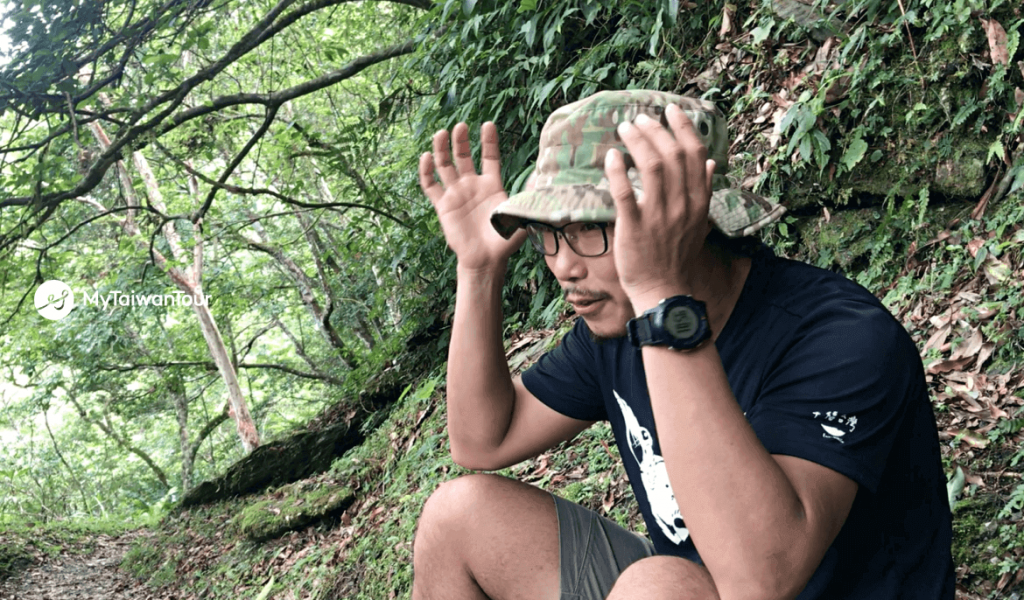Day 1 – Arriving in Hualien
Hualien from the airplane window was lovely enough to warrant a full day’s exploration, but on that day we would only be passing through. We were headed further down south in search of Taiwan’s elusive Formosan black bear (台灣黑熊). Without even stopping for coffee, we left the city by train, bound for the town of Yuli. (CNN: Taiwan used to be home to a huge number of bears. No one really knows how many are left)
In addition to our group from MyTaiwanTour, we were traveling with Amy and Rocky, a journalist and photographer team from Alive Magazine. Like us, they were looking to learn more about the shy and reclusive creature which has in recent years become a symbol of Taiwan.
Meeting Ranger Kuo – Formosan black bear expert
After checking into our guesthouse, we were met by Ranger Kuo – one of those rare people combining the boundless enthusiasm of a young man with the demonstrated life experiences of someone much older.
Kuo’s passion was bears, and he’d traveled the world studying all things Ursine.
Over an excellent meal – a sort of Hakka/Aboriginal culinary fusion at a local restaurant – Kuo told us a bit about how his interest had taken him around the world. He’d traveled to Alaska to study the grizzly, the same bears studied by the unfortunate Timothy Treadwell (whose work – and death – was chronicled in the Werner Herzog film Grizzly Man). Kuo had also been all over Asia studying the closer relatives of the Formosan black bear, including its cousins in Japan, Malaysia and China.
But like the species he’d spent most of his life studying, Kuo’s home was clearly Taiwan. He described his first face-to- face encounter with a Formosan black bear in 2009 as a near-religious experience.
“I was hiking in the mountains on a long hike, and came upon this animal standing on two legs, with big round ears. My initial thought was ‘look at those ears. It looks like Mickey Mouse.’ Then I realized what it was. It was a beautiful moment.”
Since then, Kuo has spent much of his time studying the Formosan black bear and collaborating with those seeking to help the species to increase its numbers and to preserve what remains of its natural habitat. While conceding it was highly unlikely that we’d actually meet a Formosan black bear during our brief trek, Kuo made it clear that by the time our trip was over we’d have learned plenty about the animal that had become a national symbol, adopted by Taiwanese conservationists and marketers alike.
After our meal we headed over to the Taiwan Black Bear Education and Conservation Center, an unassuming single-story building surrounded by a small park. Here, Kuo brought us up to speed on the habits and habitat of the Formosan black bear while also telling us where the species stood in relation to other bears around the globe.
Bear facts
The Formosan black bear (Ursus thibetanus formosanus) black bear is a subspecies of the Asian black bear (Ursus thibetanus) which ranges from India to China to Japan. What separates the Formosan bear is its shorter snout (earning it the nickname “dog bear”) and the fact that, unlike its cousins in China, the species is protected in Taiwan and needn’t add to its list of worries winding up in a cage having it’s bile milked by humans in search of a quick Yuan.
Though their overall population is on the uptick (a decade ago they were given up for extinct; current numbers range between 200-600), The Formosan black bear isn’t (figuratively) out of the woods yet. The species is still considered highly endangered. Habitat degradation, logging and deforestation are all culprits, and as man moves closer, the geographical geographic distribution of the bears is pushed further into higher elevations where food is scarcer.
[youtube https://www.youtube.com/watch?v=1dOZADoeryg]But, Kuo said that he felt the species could be protected and nurtured into what he considers a stable population “of about 2,000.”
Several factors back up the ranger’s optimism, including the species being protected by Taiwan’s Wildlife Conservation Act in 1989, and a long- standing taboo against hunting black bears among the Atayal, Taroko and Bunun tribes. Of course, being named as a national symbol of Taiwan’s wildlife in 2001 is another factor that favors the recovery and preservation of the Formosan black bear.
Traveling around Yulien and meeting the locals
With a lengthy hike planned for early the next day, our group spent the rest of the afternoon on a series of small warm-up hikes, first to an old Shinto shrine dating back to Japanese colonial days and later to the home of a Bunun family living close to the mountains in which the bears themselves reside.
Welcoming us into their home, the Lai family instructed us in the fine art of mochi making. This glutinous (yet strangely gluten-free) snack is made by pounding cooked rice in a gigantic wooden mortar and pestle, and is, to say the least, labor-intensive. We took turns using wielding the massive 20-pound pestle (which looked more like something an unlucky gladiator might wield employ than an actual kitchen implement) to transform rice into mochi, and were rewarded for our efforts with more mochi than we could possibly eat in one sitting.
Day 2 – Walami trail
The next morning found us at the head of the Walami trail. Originally built by the Japanese (both to facilitate logging and other resource exploitation of Taiwan’s high mountains and to facilitate their control of indigenous tribes), the trail is a small part of the much longer Batongguan Traversing Route which cuts right across Yushan National Park.
We’d only be hiking about five kilometers in, before turning back. Permits are required to go much further, and more supplies than the few bottles of water, store-bought snacks and leftover mochi that our group had brought. In any event, our goal was not to spot a Formosan black bear (which, according to Kuo, was fairly unlikely given the shyness of the species and popularity of the trail itself), but to see if we could spot evidence of their presence in still relatively low elevations.
Our small group crossed ravines and gorges, walking alongside mountain bamboo and small waterfalls. Rocky would run ahead at points to set up his camera, while Amy and I peppered Ranger Kuo with questions about the trail (which he’d hiked many, many times) and of course, about the Formosan bear. At one point we heard a crashing sound nearby, followed by a guttural chatter.
“A bear, maybe?” I asked Kuo. He laughed.
“Monkeys. There are lots of them, and they’re not shy.”
About 90 minutes into the hike, Ranger Kuo gathered the group together. Down the slope a few careful steps (or an unwisely dangerous slide) away stood a tree on which he’d spotted claw marks on the trunk. Kuo pointed at the tree with a pole and said it was possible that a bear had climbed it at some point.

Reaching the furthest point on the trail allowed for hikers without permits, we rested and had tea with a couple of other hikers on the trail before heading back down the mountain. The hike had been beautiful enough to make the fact that the only sign of bears we’d seen were a few claw marks seem less important. Despite preservation efforts, and the fact that the Formosan bear has many human allies, man still represented the greatest danger to the species.
While we all wished we’d seen an actual Formosan black bear, perhaps having not seen them wasn’t a bad thing. Stealth and shyness remains the Formosan bear’s greatest ally.
Looking to trek into the mountains, learn mochi-making from a tribal family, or perhaps even see signs of the elusive Formosan bear for yourself? Let MyTaiwanTour custom design a tour for you. Email us at [email protected] for more details!
We sincerely invite all the travelers around the world to experience a day trek through the awe-inspiring Jade Mountain National Park and to learn more about our National animal, Formosan Black Bear by joining our Formosan Bear Country Day Trek and Hot Spring Tour or customize your Formosan Black Bear journey with MyTaiwanTour. (Read also: Birdwatching In Taiwan: Advice from expert to novice)
MyTaiwanTour would like to thank UNI AIR, Taiwan Black Bear Conservation Association,and the Moon Water Bay Hill(山灣水月) for providing accommodation.

















Comments are closed.